There are many, many great books on the subject of Buddha’s teachings, so we have compiled a list you may find helpful. We have also included links to purchase on Amazon, of course you may find in or order from your local bookstore.
For the Beginner:
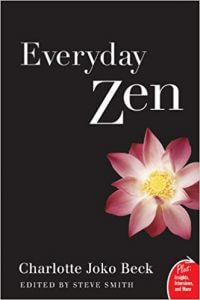 Everyday Zen by Charlotte Joko Beck This book offers a warm, engaging, uniquely American approach to using Zen to deal with the problems of daily living—love, relationships, work, fear, ambition, and suffering. Everyday Zen shows us how to live each moment to the fullest. Click here to buy.
Everyday Zen by Charlotte Joko Beck This book offers a warm, engaging, uniquely American approach to using Zen to deal with the problems of daily living—love, relationships, work, fear, ambition, and suffering. Everyday Zen shows us how to live each moment to the fullest. Click here to buy.
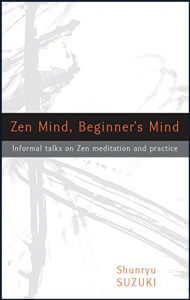 Zen Mind, Beginners Mind, by Shunryu Suzuki. “In the beginner’s mind there are many possibilities, but in the expert’s there are few.” So begins this most beloved of all American Zen books. Seldom has such a small handful of words provided a teaching as rich as has this famous opening line. Click here to buy.
Zen Mind, Beginners Mind, by Shunryu Suzuki. “In the beginner’s mind there are many possibilities, but in the expert’s there are few.” So begins this most beloved of all American Zen books. Seldom has such a small handful of words provided a teaching as rich as has this famous opening line. Click here to buy.
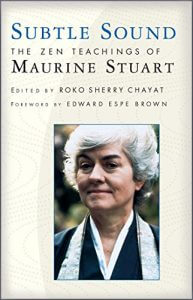 Subtle Sound: The Zen Teachings of Maurine Stuart, Edited by Sherry Chayat. Maurine Stuart (1922–1990) was one of a select group of students on the leading edge of Buddhism in America: a woman who became a Zen master. In this book, she draws on down-to-earth Zen stories, her friendships with Japanese Zen teachers, and her experiences as a concert pianist to apply the inner meanings of Buddhism to practicing the basic ethics of daily living. Click here to buy.
Subtle Sound: The Zen Teachings of Maurine Stuart, Edited by Sherry Chayat. Maurine Stuart (1922–1990) was one of a select group of students on the leading edge of Buddhism in America: a woman who became a Zen master. In this book, she draws on down-to-earth Zen stories, her friendships with Japanese Zen teachers, and her experiences as a concert pianist to apply the inner meanings of Buddhism to practicing the basic ethics of daily living. Click here to buy.
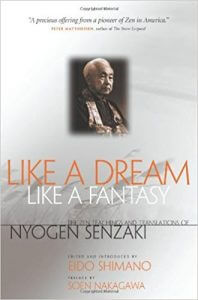 Like a Dream, Like a Fantasy: The Zen Teachings and Translations of Nyogen Senzaki, edited by Eido Shimano. Just as D.T. Suzuki introduced the West to Zen philosophy, Nyogen Senzaki helped introduce it to Zen practice, becoming the first great Japanese meditation master to fully immerse himself in the everyday life of America. Click here to buy.
Like a Dream, Like a Fantasy: The Zen Teachings and Translations of Nyogen Senzaki, edited by Eido Shimano. Just as D.T. Suzuki introduced the West to Zen philosophy, Nyogen Senzaki helped introduce it to Zen practice, becoming the first great Japanese meditation master to fully immerse himself in the everyday life of America. Click here to buy.
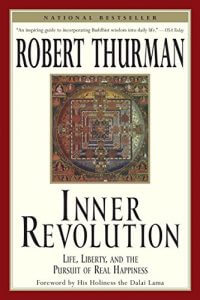 Inner Revolution: Life, Liberty, and the Pursuit of Real Happiness by Robert Thurman. The New York Times calls him “America’s number one Buddhist.” He is the co-founder of Tibet House New York, was the first American Tibetan Buddhist monk, and has shared a thirty-five-year friendship with the Dalai Lama. Click here to buy.
Inner Revolution: Life, Liberty, and the Pursuit of Real Happiness by Robert Thurman. The New York Times calls him “America’s number one Buddhist.” He is the co-founder of Tibet House New York, was the first American Tibetan Buddhist monk, and has shared a thirty-five-year friendship with the Dalai Lama. Click here to buy.
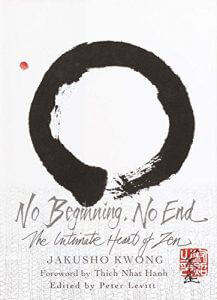 No Beginning, No End: The Intimate Heart of Zen by Jakusho Kwong Roshi. Zen master Jakusho Kwong Roshi shows us how to treasure the ordinary activities of our daily lives through an understanding of simple Buddhist practices and ideas. The author’s spontaneous, poetic, and pragmatic teachings—so reminiscent of his spiritual predecessor Shunryu Suzuki (Zen Mind, Beginner’s Mind). Click here to buy.
No Beginning, No End: The Intimate Heart of Zen by Jakusho Kwong Roshi. Zen master Jakusho Kwong Roshi shows us how to treasure the ordinary activities of our daily lives through an understanding of simple Buddhist practices and ideas. The author’s spontaneous, poetic, and pragmatic teachings—so reminiscent of his spiritual predecessor Shunryu Suzuki (Zen Mind, Beginner’s Mind). Click here to buy.
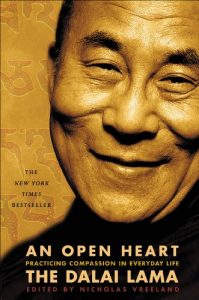
An Open Heart: Practicing Compassion in Everyday Life by The Dalai Lama. An introduction to the core of Buddhism by its greatest teacher, “An Open Heart” is the successor to the bestselling “The Art of Happiness”, the Dalai Lama’s clear and simple guide to finding compassion and happiness. Click here to buy.
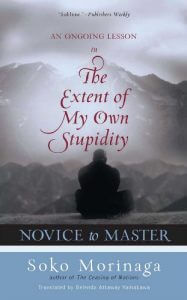
Novice to Master: An Ongoing Lesson in the Extent of My Own Stupidity by Soko Morinaga and Belenda Attaway Yamakawa. In his singularly humorous and bitingly direct way, Zen abbot Soko Morinaga tells the story of his rigorous training at a Japanese Zen temple, his spiritual growth and his interactions with his students and others. Morinaga’s voice is uniquely tuned to the truth of the condition of the human mind and spirit and his reflections and interpretations are unvarnished and succinct. Click here to buy.
Going Deeper:
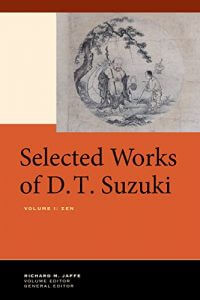 Selected Works of D.T. Suzuki, Volume I. by Daisetsu Teitaro Suzuki, Richard M. Jaffe (Editor). D. T. Suzuki was a key figure in the introduction of Buddhism to the non-Asian world. Many outside of Japan encountered Buddhism for the first time through his writings and teaching. Selected Works of D. T. Suzuki gathers the full range of Suzuki’s writings. Click here to buy.
Selected Works of D.T. Suzuki, Volume I. by Daisetsu Teitaro Suzuki, Richard M. Jaffe (Editor). D. T. Suzuki was a key figure in the introduction of Buddhism to the non-Asian world. Many outside of Japan encountered Buddhism for the first time through his writings and teaching. Selected Works of D. T. Suzuki gathers the full range of Suzuki’s writings. Click here to buy.
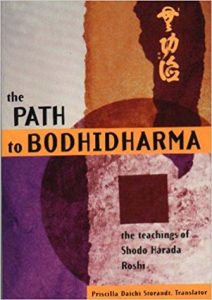 The Path to Bodhidharma: The Teachings of Shodo Harada Roshi, edited by Jane Lago. When studying ancient Eastern philosophies, it is a rare opportunity to learn the art directly from a living master. Shodo Harada Roshi is one such legend. Now Zen students of all levels can glean from Harada’s wisdom in this modern classic of Zen literature. Click here to buy.
The Path to Bodhidharma: The Teachings of Shodo Harada Roshi, edited by Jane Lago. When studying ancient Eastern philosophies, it is a rare opportunity to learn the art directly from a living master. Shodo Harada Roshi is one such legend. Now Zen students of all levels can glean from Harada’s wisdom in this modern classic of Zen literature. Click here to buy.
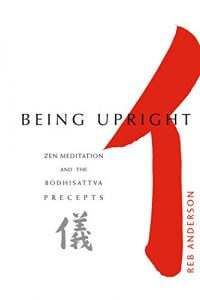 Being Upright: Zen Meditation and Bodhisattva Precepts by Tenshin Reb Anderson. Being Upright takes us beyond the conventional interpretation of ethical precepts to the ultimate meaning that informs them. Reb Anderson first introduces us to the fundamental ideas of Zen Buddhist practice. Who was Shakyamuni Buddha and what was his central teaching? Click here to buy.
Being Upright: Zen Meditation and Bodhisattva Precepts by Tenshin Reb Anderson. Being Upright takes us beyond the conventional interpretation of ethical precepts to the ultimate meaning that informs them. Reb Anderson first introduces us to the fundamental ideas of Zen Buddhist practice. Who was Shakyamuni Buddha and what was his central teaching? Click here to buy.
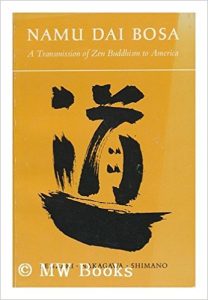 Namu Dai Bosa: A Transmission of Zen Buddhism to America, by Nyogen Senzaki, Soen Nakagawa and, Eido Shimano, edited byLouis Nordstrom. Through words, paintings, and poetry comes the mind of three great Zen Masters. Click here to buy.
Namu Dai Bosa: A Transmission of Zen Buddhism to America, by Nyogen Senzaki, Soen Nakagawa and, Eido Shimano, edited byLouis Nordstrom. Through words, paintings, and poetry comes the mind of three great Zen Masters. Click here to buy.
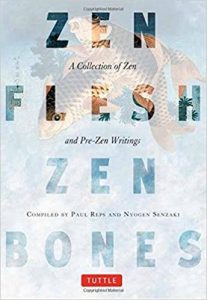 Zen Flesh, Zen Bones by Nyogen Senzaki, editor Paul Reps. When Zen Flesh, Zen Bones was published in 1957, it became an instant sensation with an entire generation of readers who were just beginning to experiment with Zen. Its popularity is as strong today as ever. Click here to buy.
Zen Flesh, Zen Bones by Nyogen Senzaki, editor Paul Reps. When Zen Flesh, Zen Bones was published in 1957, it became an instant sensation with an entire generation of readers who were just beginning to experiment with Zen. Its popularity is as strong today as ever. Click here to buy.
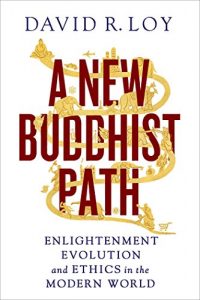 A New Buddhist Path: Enlightenment, Evolution, and Ethics in the Modern World by David R. Loy. Engage with a new vision of Buddhism and the modern world with the bestselling author of Money Sex War Karma: Notes for a Buddhist Revolution. What is the meaning of enlightenment–is it an escape from the world, or is it a form of psychological healing? Click here to buy.
A New Buddhist Path: Enlightenment, Evolution, and Ethics in the Modern World by David R. Loy. Engage with a new vision of Buddhism and the modern world with the bestselling author of Money Sex War Karma: Notes for a Buddhist Revolution. What is the meaning of enlightenment–is it an escape from the world, or is it a form of psychological healing? Click here to buy.
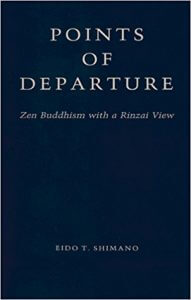 Points of Departure: Zen Buddhism with a Rinzai View by Eido Shimano. This book is about the Something, our Buddha Nature, the ultimate Reality. What is this essence of life? How can we experience it? Why is it so important to do this? What effect will this experience have in our daily lives? Click here to buy.
Points of Departure: Zen Buddhism with a Rinzai View by Eido Shimano. This book is about the Something, our Buddha Nature, the ultimate Reality. What is this essence of life? How can we experience it? Why is it so important to do this? What effect will this experience have in our daily lives? Click here to buy.
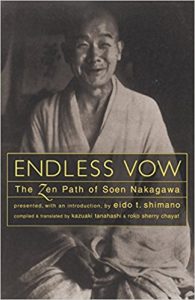 Endless Vow: The Zen Path of Soen Nakagawa, edited by Kazuaki Tanahashi and Shinge Roko Sherry Chayat. This is the first English-language collection of the literary works of Soen Nakagawa Roshi. Find an intimate, in-depth portrait of this great Zen master through his poems, letters, journal entries, and other writings, illustrated with his calligraphies. Click here to buy.
Endless Vow: The Zen Path of Soen Nakagawa, edited by Kazuaki Tanahashi and Shinge Roko Sherry Chayat. This is the first English-language collection of the literary works of Soen Nakagawa Roshi. Find an intimate, in-depth portrait of this great Zen master through his poems, letters, journal entries, and other writings, illustrated with his calligraphies. Click here to buy.
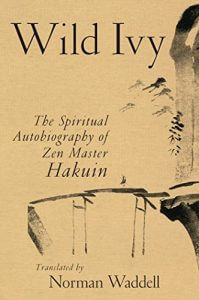 Wild Ivy: The Spiritual Autobiography of Zen Master Hakuin, Norman Waddell, translator. A fiery and intensely dynamic Zen teacher and artist, Hakuin (1685–1768) is credited with almost single-handedly revitalizing Japanese Zen after three hundred years of decline. As a teacher, he placed special emphasis on koan practice, inventing many new koans himself, including the famous “What is the sound of one hand clapping?” Click here to buy.
Wild Ivy: The Spiritual Autobiography of Zen Master Hakuin, Norman Waddell, translator. A fiery and intensely dynamic Zen teacher and artist, Hakuin (1685–1768) is credited with almost single-handedly revitalizing Japanese Zen after three hundred years of decline. As a teacher, he placed special emphasis on koan practice, inventing many new koans himself, including the famous “What is the sound of one hand clapping?” Click here to buy.
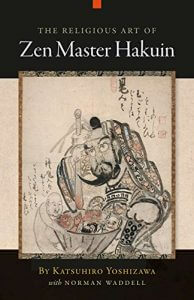 The Religious Art of Zen Master Hakuin, Katsuhiro Yoshizawa, with Norman Waddell. A charismatic and extraordinary Zen teacher and artist, Hakuin (1686–1769) is credited with almost single-handedly reforming and revitalizing Japanese Zen from a state of extreme spiritual decline. Click here to buy.
The Religious Art of Zen Master Hakuin, Katsuhiro Yoshizawa, with Norman Waddell. A charismatic and extraordinary Zen teacher and artist, Hakuin (1686–1769) is credited with almost single-handedly reforming and revitalizing Japanese Zen from a state of extreme spiritual decline. Click here to buy.
Teachings and Koan Practice:
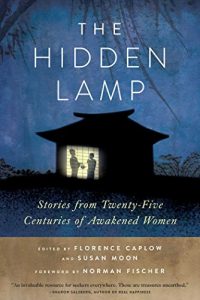 The Hidden Lamp: Stories from Twenty-Five Centuries of Awakened Women, Florence Caplow and Susan Moon, editors. This collection of one hundred koans and stories of Buddhist women from the time of the Buddha to the present day is a revolutionary book. It brings together many teaching stories that were hidden for centuries and unknown until this volume. Click here to buy.
The Hidden Lamp: Stories from Twenty-Five Centuries of Awakened Women, Florence Caplow and Susan Moon, editors. This collection of one hundred koans and stories of Buddhist women from the time of the Buddha to the present day is a revolutionary book. It brings together many teaching stories that were hidden for centuries and unknown until this volume. Click here to buy.
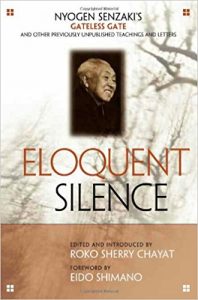 Eloquent Silence: Nyogen Senzaki’s Gateless Gate and Other Previously Unpublished Teachings and Letters, Shinge Roko Sherry Chayat, editor. The most comprehensive collection available of Nyogen Senzaki’s brilliant teachings, Eloquent Silence brings new depth and breadth to our knowledge and appreciation of this historic figure. It makes available for the first time his complete commentaries on the Gateless Gate, one of the most important and beloved of all Zen texts, as well as on koans from the Blue Rock Annals and the Book of Equanimity. Click here to buy.
Eloquent Silence: Nyogen Senzaki’s Gateless Gate and Other Previously Unpublished Teachings and Letters, Shinge Roko Sherry Chayat, editor. The most comprehensive collection available of Nyogen Senzaki’s brilliant teachings, Eloquent Silence brings new depth and breadth to our knowledge and appreciation of this historic figure. It makes available for the first time his complete commentaries on the Gateless Gate, one of the most important and beloved of all Zen texts, as well as on koans from the Blue Rock Annals and the Book of Equanimity. Click here to buy.
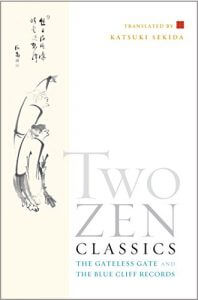 Two Zen Classics: Mumonkan & Hekiganroku, Katsuki Sekida translator. The strange verbal paradoxes called koans have been used traditionally in Zen training to help students attain a direct realization of truths inexpressible in words. The two works translated in this book, Mumonkan (The Gateless Gate ) and Hekiganroku (The Blue Cliff Record) are the best known and most frequently studied koan collections. Click here to buy.
Two Zen Classics: Mumonkan & Hekiganroku, Katsuki Sekida translator. The strange verbal paradoxes called koans have been used traditionally in Zen training to help students attain a direct realization of truths inexpressible in words. The two works translated in this book, Mumonkan (The Gateless Gate ) and Hekiganroku (The Blue Cliff Record) are the best known and most frequently studied koan collections. Click here to buy.
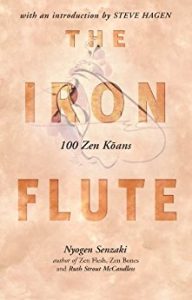 The Iron Flute by Nyogen Senzaki with Ruth McCandless. In this new edition of The Iron Flute, one hundred of the most challenging and enlightening koan from the Chinese Chan (Zen) patriarchs of the Tang and Sung dynasties are presented, along with commentary from the great Zen masters Genro, Fugai, and Nyogen, plus an in-depth biography of author Nyogen Senzaki, a pioneer in bringing Zen Buddhism to the West. Click here to buy.
The Iron Flute by Nyogen Senzaki with Ruth McCandless. In this new edition of The Iron Flute, one hundred of the most challenging and enlightening koan from the Chinese Chan (Zen) patriarchs of the Tang and Sung dynasties are presented, along with commentary from the great Zen masters Genro, Fugai, and Nyogen, plus an in-depth biography of author Nyogen Senzaki, a pioneer in bringing Zen Buddhism to the West. Click here to buy.
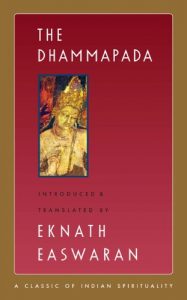 The Dhammapada, edited by Eknath Easwaran. Dhammapada means “the path of dharma,” the path of harmony and righteousness that anyone can follow to reach the highest good.The Dhammapada is a collection of verses, gathered probably from direct disciples who wanted to preserve what they had heard from the Buddha himself. Easwaran’s best-selling translation of this classic Buddhist text is based on the original Pali. Click here to buy.
The Dhammapada, edited by Eknath Easwaran. Dhammapada means “the path of dharma,” the path of harmony and righteousness that anyone can follow to reach the highest good.The Dhammapada is a collection of verses, gathered probably from direct disciples who wanted to preserve what they had heard from the Buddha himself. Easwaran’s best-selling translation of this classic Buddhist text is based on the original Pali. Click here to buy.
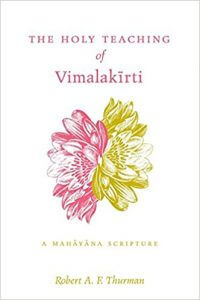 The Holy Teaching of Vimalakirti, Robert Thurman, translator. This book presents the major teachings of Mahāyāna Buddhism in a precise, dramatic, and even humorous form. For two millennia, this Sūtra, called the “jewel of the Mahāyāna Sūtras,” has enjoyed immense popularity among Mahāyāna Buddhists worldwide. Click here to buy.
The Holy Teaching of Vimalakirti, Robert Thurman, translator. This book presents the major teachings of Mahāyāna Buddhism in a precise, dramatic, and even humorous form. For two millennia, this Sūtra, called the “jewel of the Mahāyāna Sūtras,” has enjoyed immense popularity among Mahāyāna Buddhists worldwide. Click here to buy.
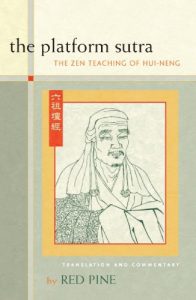 The Platform Sutra: The Zen Teaching of Hui-Neng, Red Pine, translator, commentator. This sutra occupies a central place in Zen (Ch’an) Buddhist instruction for students and spiritual seekers worldwide. It is often linked with The Heart Sutra and The Diamond Sutra to form a trio of texts that have been revered and studied for centuries. Click here to buy.
The Platform Sutra: The Zen Teaching of Hui-Neng, Red Pine, translator, commentator. This sutra occupies a central place in Zen (Ch’an) Buddhist instruction for students and spiritual seekers worldwide. It is often linked with The Heart Sutra and The Diamond Sutra to form a trio of texts that have been revered and studied for centuries. Click here to buy.